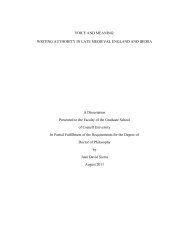CARPET WEAVERS AND WEAVING IN THE ... - Cornell University
CARPET WEAVERS AND WEAVING IN THE ... - Cornell University
CARPET WEAVERS AND WEAVING IN THE ... - Cornell University
Create successful ePaper yourself
Turn your PDF publications into a flip-book with our unique Google optimized e-Paper software.
As Landreau points out, “material changes in rug production clearly mirror<br />
social change” (Landreau 1996, 11). This was likely the case since the inception of<br />
carpet weaving and is therefore likely the case today as well. Both the tourist market<br />
and the export market have changed the patterns and dimension of carpets. Factors<br />
influencing these changes have included the needs of the antique market, the<br />
requirements of the tourist market, and the actual or perceived aesthetics of global<br />
(mainly western) consumers. These factors have influenced design and construction<br />
of carpets most likely from the fist time a woman wove a carpet for sale outside of her<br />
community. They are moderated by the ways in which the designer (weaver, dealer or<br />
other manager) perceives customer desire. For a weaver this may be through seeing<br />
what dealers buy (Breu and Marchese 1999, 244), or what is being sold (and bought)<br />
at local markets. For a dealer this may be looking at what sells best for them and for a<br />
manager there may be other methods of gauging customer desire. Weavers, in the case<br />
of petty-commodity production, and those who decide on patterns under the workshop<br />
and putting-out system, respond not only to market demand, but to perceived market<br />
demand that may or may not reflect the actual desires of the market.<br />
In the 1960s customers seeking Turkish carpets were mainly interested in<br />
antiques. In order to sell carpets, dealers who did not have access to antique carpets<br />
“aged” new rugs in order to pass them off as older carpets. This involved bleaching<br />
the carpets and cutting back the black yarns that were worn away in genuine antiques<br />
due to the tin used as a mordant in the dye (Jirousek 1994, 229). Eventually dealers<br />
stopped selling such carpets as antiques, but bleaching carpets and cutting back the<br />
black yarns had become a routine part of the finishing process (Jirousek 1994, 233)<br />
and possibly something that foreigners expected to see when they went to buy Turkish<br />
carpets (see Figure 2.4). In this way dealers and customers helped shape the current<br />
concepts of “authentic” Turkish carpets.<br />
32

















